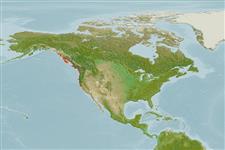>
Perciformes/Cottoidei (Sculpins) >
Cottidae (Sculpins)
Etymology: Ascelichthys: Greek, askeles, -es, -es = tough, dry, hard (Ref. 45335); rhodorus: Ascelichthys literally a fish w/o legs=pelvic fins; rhodorus rose margin, referring to the color of the lips (Ref. 4930).
More on authors: Jordan & Gilbert.
Environment: milieu / climate zone / depth range / distribution range
Ökologie
seewasser demersal. Temperate; 59°N - 34°N
Eastern Pacific: Sitka, Alaska to San Mateo, central California, USA.
Size / Gewicht / Alter
Maturity: Lm ? range ? - ? cm
Max length : 15.0 cm TL Männchen/unbestimmt; (Ref. 2850)
Rückenflossenstacheln (insgesamt) : 7 - 10; Rückenflossenweichstrahlen (insgesamt) : 17 - 20; Afterflossenstacheln: 0; Afterflossenweichstrahlen: 13 - 16. Caudal well rounded.
Intertidal (Ref. 31184) and inhabits tide pools and rocky inshore areas on exposed coasts (Ref. 2850). May remain out of water under rocks or seaweeds (Ref. 31184). Breathes air when out of water (Ref. 31184).
Life cycle and mating behavior
Maturities | Fortpflanzung | Spawnings | Egg(s) | Fecundities | Larven
Eschmeyer, W.N., E.S. Herald and H. Hammann, 1983. A field guide to Pacific coast fishes of North America. Boston (MA, USA): Houghton Mifflin Company. xii+336 p. (Ref. 2850)
IUCN Rote Liste Status (Ref. 130435)
Bedrohung für Menschen
Harmless
Nutzung durch Menschen
Tools
Zusatzinformationen
Download XML
Internet Quellen
Estimates based on models
Preferred temperature (Ref.
123201): 9 - 12.8, mean 10.4 °C (based on 139 cells).
Phylogenetic diversity index (Ref.
82804): PD
50 = 1.0000 [Uniqueness, from 0.5 = low to 2.0 = high].
Bayesian length-weight: a=0.00676 (0.00300 - 0.01523), b=3.17 (2.98 - 3.36), in cm total length, based on LWR estimates for this (Sub)family-body shape (Ref.
93245).
Trophic level (Ref.
69278): 3.4 ±0.5 se; based on size and trophs of closest relatives
Widerstandsfähigkeit (Ref.
120179): mittel, Verdopplung der Population dauert 1,4 - 4,4 Jahre. (Preliminary K or Fecundity.).
Fishing Vulnerability (Ref.
59153): Low vulnerability (10 of 100).
